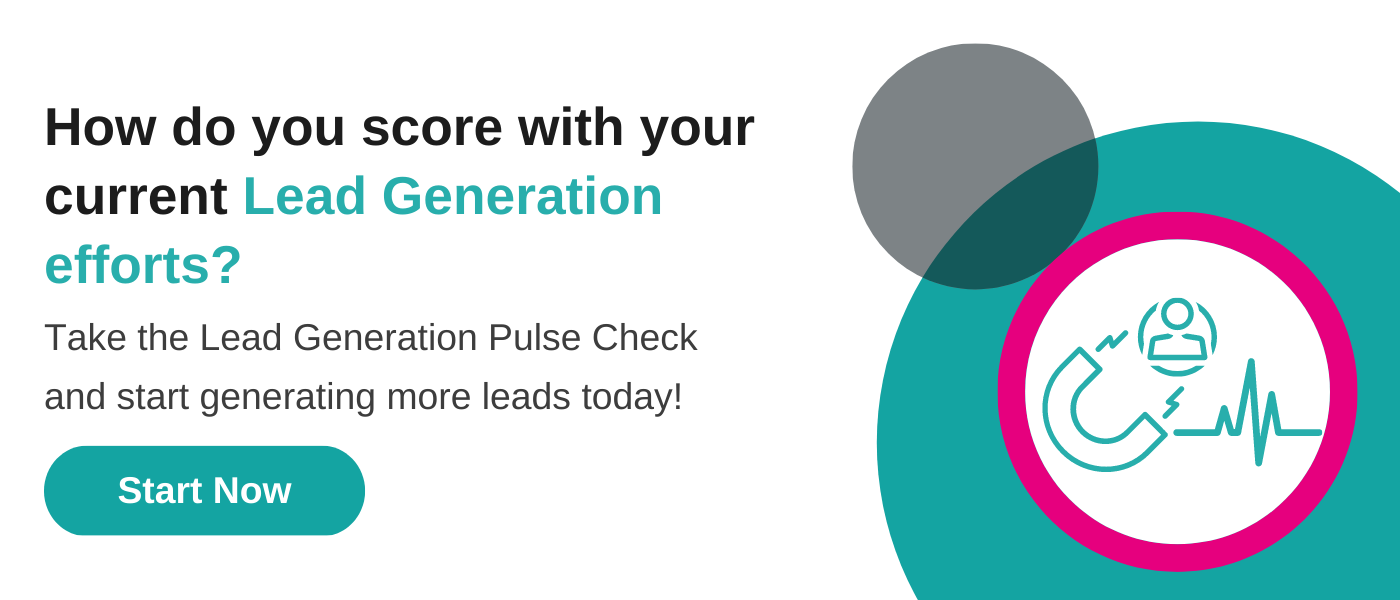Business owners often think ‘more leads’ means ‘more sales’. As a result, they’re constantly on the hunt for new ways to generate leads. It’s a natural impulse: but a lot of the time, it’s a mistake.
Don’t get us wrong, generating new leads is important. But it’s equally important to look at what you’re doing with the ones you already have.
A leaky bucket ends up empty no matter how much you fill it. You may be generating hundreds of leads a day, but if they’re not being supplied with quotes, followed up and nurtured, it’s a massive waste of time and money.
This guide will walk you through the B2B lead generation process step-by-step. We’ll cover:
- What we mean by sales leads, MQLs and SQLs
- How to generate new leads using inbound and outbound marketing
- How to ‘nurture’ leads using email
- How to use lead scoring to prioritise your best leads
- How CRMs can help and how to choose the right one for your business
But first, we need to go back to basics.
What is a sales lead?
For many businesses, the hardest part of lead generation is working out what a ‘good’ lead is for your business.
Business leaders, salespeople and marketers often have totally different interpretations. Sales think a lead is a red-hot contact who’s ready to purchase there and then. Marketing think it’s someone who’s given their email address and is happy to be contacted.
Both are right - but at different stages of the lead gen process. Here’s a neat way of breaking the process down into stages:
- Contact - has filled out a form and provided their contact details
- Marketing qualified lead (MQL) - match your ideal customer profile and represent a possible future opportunity.
- Sales qualified lead (SQL) - have spoken to sales, expressed an interest in working with you and represent a genuine near-term opportunity
- Customer - have bought from you in the past
It’s crucial for your marketers and salespeople to appreciate the differences between these definitions. The number one reason sales and marketing teams struggle to work together is misalignment around contacts, MQLs and SQLs. If marketing consistently pass poorly qualified leads to sales, the sales team inevitably stops following up on them altogether.
BANT is a tried-and-tested way to qualify sales leads:
- Budget - can the prospect afford what you’re selling and have they decided to spend?
- Authority - is the purchase decision theirs to make?
- Need - have you established why they need your product or service?
- Timescale - when do they need to make the call?
Alternatively, check out this useful exercise that will help your marketing and sales team agree on what a ‘good’ lead means for your business.
How can you generate B2B leads for your business?
There’s no one-size-fits-all approach to lead generation. Every company is different, as is every customer journey. But there are some common tactics that it’s worth knowing. These can broadly be grouped into two categories: inbound and outbound.
Inbound vs outbound marketing: what’s the difference?
Outbound tactics reach out to your market. A few examples of this would be email, direct mail and TV advertising. Inbound tactics draw your market to you (typically to your website). Two examples of this would be search engine optimisation and posting content on social media.
Outbound marketing tends to be interruptive. The customer hasn’t asked for you to send them the email or show them the ad, but you hope that once they see it they’ll respond in a positive way. Inbound marketing is the opposite. The customer elects to click the link that takes them to your website because you’ve shared something that they find interesting or useful.
Should you choose inbound or outbound marketing?
Most businesses don’t do one or the other. They choose a combination of the two based on the situation they’re in. The real question isn’t which should you do, but what’s the best way to decide which combination of tactics is right for you?
Here are a few questions that will help.
What’s the data telling you to do?
Your next customers are likely to look like your previous ones. So a great place to start is your historical sales data. What customer segments typically buy from you? How did they find you, what did they buy and what was it that convinced them that you were right? Understanding your previous successes will help you replicate them.
What’s your timeframe for results?
One of the advantages of outbound marketing is that it can deliver short-term results. An advert in the right journal, a well-timed email or a short phone campaign right before a major trade show can deliver results fast.
Inbound often demands more patience, with leads engaging at their own pace. However, once established, inbound channels can become “the gift that keeps giving’.
How content marketing supports B2B lead generation
Content marketing can be blog posts, webinars, ebooks, video, social media, infographics - you name it. As long as it’s focused on adding value rather than directly promoting your services, it’s content marketing.
This blog post is a good example of content marketing. We’re not pitching our services directly. We’re just sharing our ideas and trying to be helpful. We’ve been creating content for more than ten years now and we’re not going to stop anytime soon, because it’s very effective.
Content plays a key role in B2B lead generation. Whether you’re choosing outbound or inbound tactics, content will help you earn attention, build trust and establish credibility. Ideally, it will also share your unique ideas and opinions and help to differentiate you from competitors.
Here are a few content tips based on our experience (get a deep dive here for more info):
- Be crystal clear about your audience
- Pick specific topics you know will be of interest
- Invest time and money in quality content
- Make distribution a priority
- Regularly review performance and adapt
How do you ‘nurture’ B2B leads?
Lead generation can be neatly split into two separate activities: ‘lead generation’ and ‘lead nurture’. Lead nurture is the process of turning new contacts or enquiries into MQLs so you can pass them on to sales to be qualified as an SQL.
This is a long-term activity. Only around 5% of your market will ever be ready to buy at any given time. Lead nurture is the process of staying front-of-mind with leads over time, so you keep the relationship going until they’re ready to buy.
Lead nurture typically happens over email. The campaign may be highly personalised based on the insight you have into specific customers. Or it may be broader, targeting a whole market segment with less personalised material. An alternative to email is for sales to call and check in on a regular basis.
The key factors are pacing and structure. Nurturing a lead is a careful process that relies on delivering value, encouraging engagement and then gently leading the contact towards a next step - often booking a sales call or making a purchase.
Nurturing through email - a practical example
An email nurture campaign is often broken down into stages designed to build confidence and trust over time. Here’s a typical structure.
- Welcome email. Thank the reader for downloading your content or signing up to your mailing list, provide a breakdown of your products or services and link out to relevant web pages. Tell them what you do without pushing them to buy.
- Problem-solution email. Explore a problem the contact might be experiencing - perhaps in a blog post that you’ll tee up in the email. Make sure the prospect has to click through and land on your website to finish consuming the content - to find the solution to their problem.
- A case study. Provide an example of a happy client - again, keeping the bulk of the content out of the email to ensure prospects click through to your website, becoming more engaged with you and your message.
- A call to action. Close the campaign with a short sales message asking the recipient to get in touch with your sales team. Now they know what you can do for them, and what you’ve done for people like them, they’ll sell to themselves - they’ll make the choice to convert.
The key thing to notice is that we’re not asking them to buy straight off the bat. The goal is to build the relationship over time and then ask them when they’re ready.
You can get a deep dive on this approach here if you’re looking for more information.
How to use lead scoring to prioritise your best leads
‘Lead scoring’ is how you prioritise the many leads you could pursue. Based on the information they’ve given and their behaviour, you can rate leads and decide which matter most.
How do you identify the ‘best’ leads? This will vary. You might sort by demographic. Do information professionals buy products faster than any other job title on your client list? Do you perform better in particular locations, or sell more to particular industries? Your sales data will show you which types of customer to prioritise.
Alternatively, you might focus on activity: do most of your conversions download the same content from or watch the same videos on your website? Does activity trail off after a certain span of time - ten days or eight weeks or three months? Who’s opening and clicking through your emails reliably, or reposting your social media output?
Most commonly there are 3 perspectives that we can use to prioritise by activity:
- Volume – how much content has been consumed?
- Recency – was it consumed this week or last month? Clearly someone who has been reading your content recently should be a greater priority who visited lots of pages six months ago (find out how to reactivate those leads)
- Destination – specific pages on your website may provide a stronger indication of purchase intent than others. For instance, a pricing page or an implementation guide should be scored higher than a top-level page.
How do you assign the scores? The exact numbers don’t matter, but the process does. Points are awarded for extent of engagement, repeated actions - and they’re deducted from prospects who’ve stopped engaging or are of less interest to you (eg. students or job-seekers).
Demographic and activity-based scoring are not mutually exclusive. Most companies find a lead scoring system based on a combination of demographics and activity works best. But try to keep it simple. Complexity can do more harm than good as the scores become harder to interpret.
If you’re only handling a handful of leads, you can get by with notebooks and business cards, but if you’re working with dozens, hundreds or thousands, you’re going to need to automate things. That’s where the Customer Relationship Management (CRM) system comes in.
How to use your CRM to track leads
There are countless marketing tools out there. But none matter more than your CRM. Your CRM system is the beating heart of your B2B lead generation efforts.
It stores all your lead and customer data, either entered directly by the sales team or captured automatically from your campaign tools and website. Several CRMs (like Hubspot, which is what we use) can also send emails, trigger automated campaigns when certain conditions are met, create landing pages and track website activity. Our entire website is built on Hubspot, which means every website interaction is tracked and fed into our lead generation programmes.
The CRM plays a vital role in every step of the process that we’ve outlined so far. It stores new contacts, tracks their progress from MQL to SQL and triggers activity that can make this happen faster. While it’s generally much simpler to do this through one fully integrated system such as HubSpot or Zoho, most popular platforms offer integrations to the major CRM platforms.
The CRM can also track why you’re losing business and the points in the lead generation process where leads are getting stuck. Knowing what’s broken is just as important as knowing what’s working.
Choosing the right CRM
There are countless options out there and choosing the right CRM for your business can be more art than science. What’s suitable now may not be in a year or two’s time - what’s affordable now may be expensive at larger scales.
Buying a CRM is mostly about understanding exactly which processes it’s meant to help with and which problems it’s meant to solve. The key questions to answer are:
- What do you need the CRM to manage besides customer data? Project management, product or service details, company events, sales forecasts?
- Who will be using the system? Salesforce, unsurprisingly, is geared toward the needs and style of sales personnel, but if you’re using the system for tasks across the whole business, something more general will be called for.
- What budget is available? Most free or cheap CRMs are only free or cheap up to a certain number of users or customers or have limited facilities in the free version
- Do I need a scalable system? A free system limited to five users may be fine for a startup, but what happens if your team goes to twelve in your second year? Think about future-proofing: how easy and expensive it is to add users, functions and flexibility down the line.
- What do I want to integrate with my CRM? Most CRMs integrate fine with MS Office, but what about websites? Telephone systems? Accounting software? Be sure to find out what options exist.
Once you’ve answered those questions, you’ll have a much clearer idea of what you’re looking for in a CRM, and you’ll be that much better equipped to shop around.
Generate sales leads that close
Lead generation is always a priority for our customers. The best way to improve your lead generation performance is often to work on what happens after you generate a lead, rather than how to get more of them.
Setting clear criteria for MQLs and SQLs, choosing the right tactics, understanding lead nurture and prioritising opportunities will all help you convert more leads into customers without generating more leads.
Want an expert opinion on where to start with your lead generation process? Take two minutes to try our Lead Generation Pulse Check to discover your strengths and weaknesses and where to focus.





